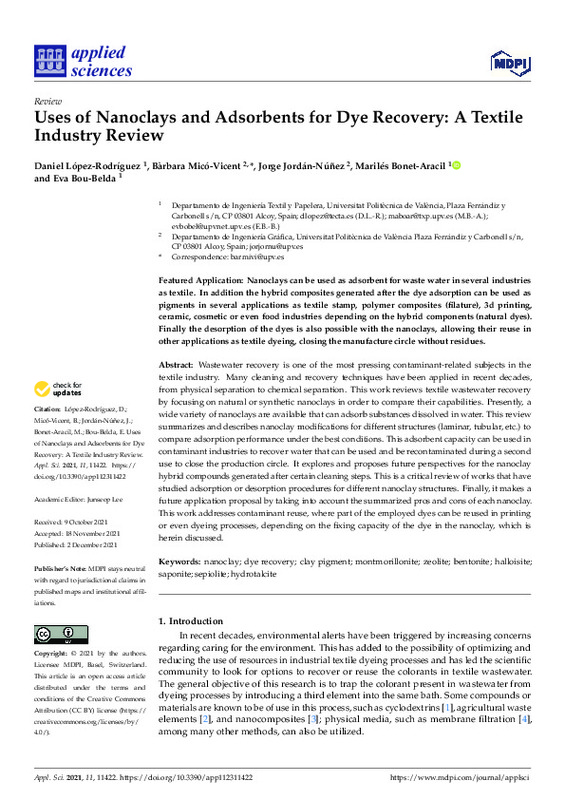JavaScript is disabled for your browser. Some features of this site may not work without it.
Buscar en RiuNet
Listar
Mi cuenta
Estadísticas
Ayuda RiuNet
Admin. UPV
Uses of Nanoclays and Adsorbents for Dye Recovery: A Textile Industry Review
Mostrar el registro sencillo del ítem
Ficheros en el ítem
| dc.contributor.author | López-Rodríguez, Daniel
|
es_ES |
| dc.contributor.author | Micó-Vicent, B.
|
es_ES |
| dc.contributor.author | Jordán-Núñez, Jorge
|
es_ES |
| dc.contributor.author | BONET-ARACIL, MARILÉS
|
es_ES |
| dc.contributor.author | Bou-Belda, Eva
|
es_ES |
| dc.date.accessioned | 2022-05-09T18:04:59Z | |
| dc.date.available | 2022-05-09T18:04:59Z | |
| dc.date.issued | 2021-12 | es_ES |
| dc.identifier.uri | http://hdl.handle.net/10251/182452 | |
| dc.description.abstract | [EN] Wastewater recovery is one of the most pressing contaminant-related subjects in the textile industry. Many cleaning and recovery techniques have been applied in recent decades, from physical separation to chemical separation. This work reviews textile wastewater recovery by focusing on natural or synthetic nanoclays in order to compare their capabilities. Presently, a wide variety of nanoclays are available that can adsorb substances dissolved in water. This review summarizes and describes nanoclay modifications for different structures (laminar, tubular, etc.) to compare adsorption performance under the best conditions. This adsorbent capacity can be used in contaminant industries to recover water that can be used and be recontaminated during a second use to close the production circle. It explores and proposes future perspectives for the nanoclay hybrid compounds generated after certain cleaning steps. This is a critical review of works that have studied adsorption or desorption procedures for different nanoclay structures. Finally, it makes a future application proposal by taking into account the summarized pros and cons of each nanoclay. This work addresses contaminant reuse, where part of the employed dyes can be reused in printing or even dyeing processes, depending on the fixing capacity of the dye in the nanoclay, which is herein discussed | es_ES |
| dc.language | Inglés | es_ES |
| dc.publisher | MDPI AG | es_ES |
| dc.relation.ispartof | Applied Sciences | es_ES |
| dc.rights | Reconocimiento (by) | es_ES |
| dc.subject | Nanoclay | es_ES |
| dc.subject | Dye recovery | es_ES |
| dc.subject | Clay pigment | es_ES |
| dc.subject | Montmorillonite | es_ES |
| dc.subject | Zeolite | es_ES |
| dc.subject | Bentonite | es_ES |
| dc.subject | Halloisite | es_ES |
| dc.subject | Saponite | es_ES |
| dc.subject | Sepiolite | es_ES |
| dc.subject | Hydrotalcite | es_ES |
| dc.subject.classification | INGENIERIA TEXTIL Y PAPELERA | es_ES |
| dc.subject.classification | EXPRESION GRAFICA EN LA INGENIERIA | es_ES |
| dc.title | Uses of Nanoclays and Adsorbents for Dye Recovery: A Textile Industry Review | es_ES |
| dc.type | Artículo | es_ES |
| dc.identifier.doi | 10.3390/app112311422 | es_ES |
| dc.rights.accessRights | Abierto | es_ES |
| dc.contributor.affiliation | Universitat Politècnica de València. Departamento de Ingeniería Textil y Papelera - Departament d'Enginyeria Tèxtil i Paperera | es_ES |
| dc.contributor.affiliation | Universitat Politècnica de València. Departamento de Ingeniería Gráfica - Departament d'Enginyeria Gràfica | es_ES |
| dc.description.bibliographicCitation | López-Rodríguez, D.; Micó-Vicent, B.; Jordán-Núñez, J.; Bonet-Aracil, M.; Bou-Belda, E. (2021). Uses of Nanoclays and Adsorbents for Dye Recovery: A Textile Industry Review. Applied Sciences. 11(23):1-27. https://doi.org/10.3390/app112311422 | es_ES |
| dc.description.accrualMethod | S | es_ES |
| dc.relation.publisherversion | https://doi.org/10.3390/app112311422 | es_ES |
| dc.description.upvformatpinicio | 1 | es_ES |
| dc.description.upvformatpfin | 27 | es_ES |
| dc.type.version | info:eu-repo/semantics/publishedVersion | es_ES |
| dc.description.volume | 11 | es_ES |
| dc.description.issue | 23 | es_ES |
| dc.identifier.eissn | 2076-3417 | es_ES |
| dc.relation.pasarela | S\451650 | es_ES |
| dc.subject.ods | 08.- Fomentar el crecimiento económico sostenido, inclusivo y sostenible, el empleo pleno y productivo, y el trabajo decente para todos | es_ES |
| upv.costeAPC | 1909,38 | es_ES |








